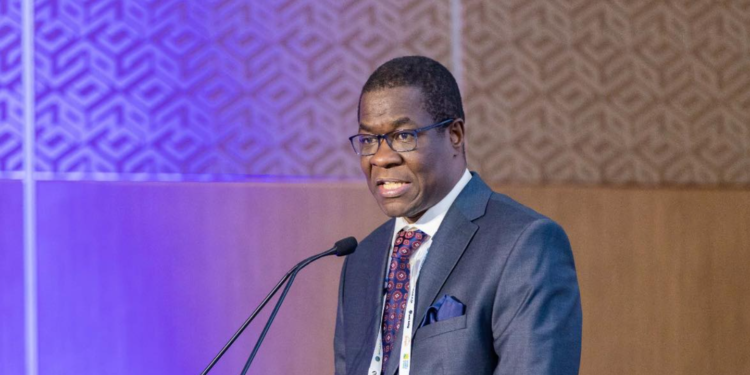Kenya has signed a agreement with India’s Adani Energy Solutions Ltd to construct and operate major transmission lines and substations, aimed at tackling the country’s persistent power shortages. The KES 95.68 billion ($736 million0 project, which will span over 30 years, is expected to significantly strengthen the national grid and improve electricity reliability, critical to Kenya’s economic growth.
Speaking at the signing ceremony, Opiyo Wandayi, Cabinet Secretary for Energy and Petroleum, announced that the partnership between the Kenya Electricity Transmission Company Limited (KETRACO) and Adani marks a “transformative initiative” to expand the country’s energy infrastructure. The project will focus on several high-capacity transmission lines and substations across key regions, intended to address widespread blackouts and ensure reliable electricity access for businesses and households alike.
“Kenya has been grappling with frequent power interruptions that hinder economic progress and disrupt lives. This agreement marks a major step towards solving these challenges by ensuring the development of world-class energy infrastructure, which will underpin Kenya’s development goals,” Wandayi said.
Strategic Projects Target Power Reliability
The deal outlines the construction of several critical power transmission lines, including the 400kV Gilgil-Thika-Malaa-Konza line, spanning 208 km, as well as the 220kV Rongai-Keringet-Chemosit line and the 132kV Menengai-Ol Kalou-Rumuruti line, covering more than 180 km in total. These lines will incorporate new substations at strategic locations to boost regional power distribution.
In addition to these, a 400/220kV substation at Lessos and a 132/33kV substation at Thurdibuoro will be built to stabilize the grid and expand access to underserved areas. Wandayi noted that these infrastructure developments are crucial for supporting Kenya’s industrial growth and enhancing regional integration.
Adani Energy Solutions, which will oversee the project’s financing, construction, and long-term operation, will be responsible for raising the required capital through a combination of debt and equity. The firm will manage the project for 30 years, after which the assets will be handed over to KETRACO.
“The Kenyan government will not incur any financial cost for this project. Adani will secure all necessary funding, and the competitive bidding process will prioritize value for money, local content, and business opportunities for Kenyan enterprises,” Wandayi added. The bidding process, jointly managed by KETRACO and Adani, is designed to ensure transparency and efficiency.
Key to Economic Transformation
The transmission upgrade is set to play a critical role in Kenya’s long-term development strategy. The project aligns with the government’s Vision 2030 initiative, which seeks to transition Kenya into a middle-income, industrialized nation. By enhancing electricity transmission capacity, the government aims to boost industrial activity and regional integration.
Furthermore, the project is expected to support the government’s Bottom-Up Economic Transformation Agenda, which emphasizes equitable growth by expanding access to essential infrastructure such as electricity. “This project will not only bolster our energy infrastructure but also contribute to economic and social transformation by creating job opportunities and stimulating local economic activity,” Wandayi emphasized.
Addressing Power Deficits
Kenya has faced recurrent power blackouts, a long-standing issue that has stifled both businesses and households. Power interruptions have caused significant economic losses, particularly in sectors reliant on stable energy supplies, such as manufacturing and services. Enhancing the country’s transmission infrastructure is expected to minimize transmission losses, improve the efficiency of power distribution, and reduce blackouts.
The initiative also forms part of a broader government strategy to increase access to electricity for all Kenyans, particularly in rural and underserved areas. The substation at Thurdibuoro is expected to provide electricity to communities that have long lacked reliable power, thus empowering local economies and fostering development.
The 400kV Gilgil-Thika-Malaa-Konza line will also play a crucial role in connecting some of Kenya’s fastest-growing regions, enabling smoother power distribution and reducing strain on existing infrastructure.
Long-Term Benefits
Wandayi highlighted the long-term sustainability of the project, emphasizing that after 30 years of operation under Adani Energy Solutions, the transmission assets will be transferred to KETRACO. The partnership is part of a broader push by the government to ensure that strategic infrastructure projects are sustainable, efficient, and aligned with national development goals.
Before signing the agreement, KETRACO conducted thorough due diligence on Adani Energy Solutions, including comprehensive stakeholder engagement. Wandayi stressed that the government is fully committed to ensuring the timely and successful implementation of the project.
“This is not just a project; it is a national priority. It is one of the many initiatives the government is undertaking to secure the future of Kenya’s energy supply,” Wandayi concluded.
The partnership is expected to deliver a reliable electricity network capable of supporting Kenya’s growing demand, which has been driven by a rapidly expanding population and increasing industrial activity. With electricity playing a central role in economic growth, the success of this project could set a precedent for future energy infrastructure investments in the region.


















